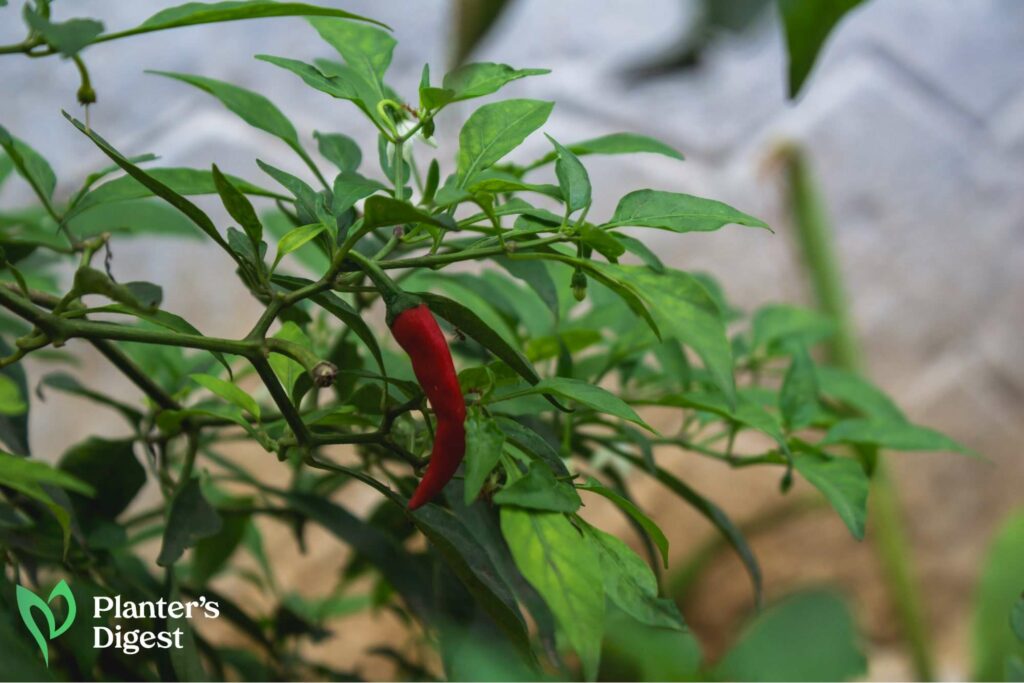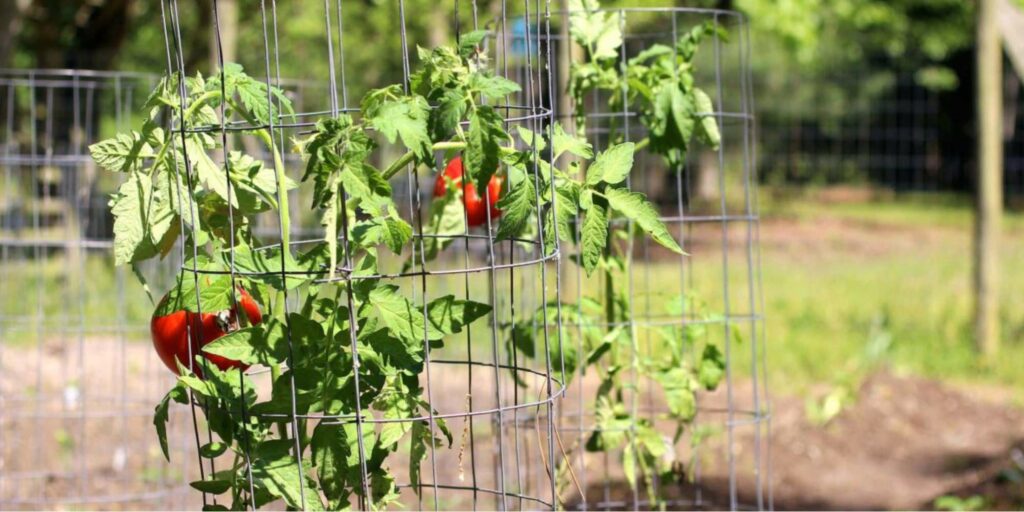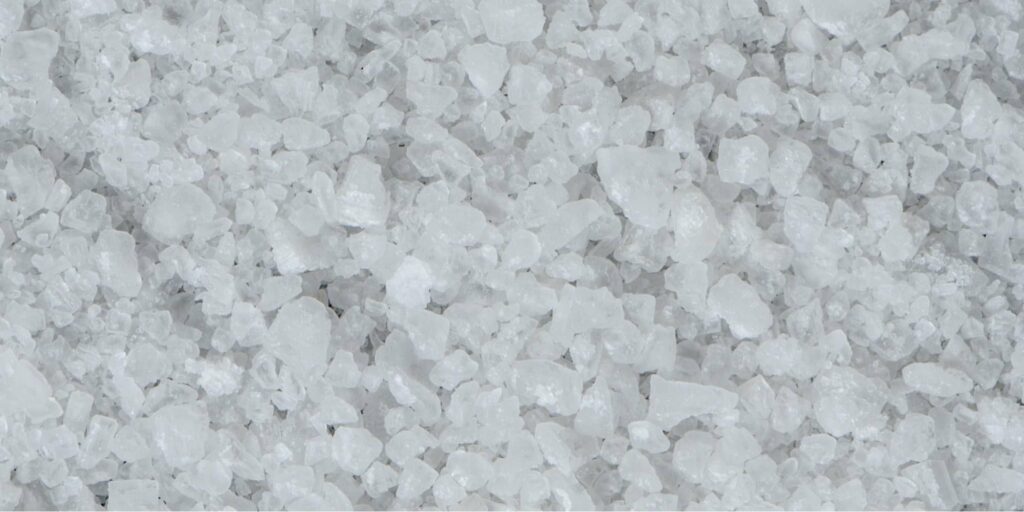When leaves darken and droop down to the ground, it’s a telltale sign of trouble for your pepper plant.
Pepper plants are highly susceptible to wilting, brought about by different factors. In this article, we’ll walk you through all the causes of wilting on pepper plants and how to prevent this from happening again. Let’s get started!
Why are your pepper plants wilting?
Pepper plants suffer from wilting because of changes in growing conditions, pest infestation and contraction of plant diseases.
Below, we’ll tackle each cause of wilting pepper plants and how to fix them.
1. Lack of Water
How To Fix: Practice drip irrigation.
Watering is a primary gardening task, but you might be surprised how many gardeners fail to do so in their pepper plants. Lack of water is one of the most common causes of wilting pepper plants.
The process of leaves losing water is called transpiration. When plants become dry, they do not have enough water to keep their leaves turgid, leaving them to droop to the ground.
As the pepper plant loses more water than it takes in, the leaves stems, and other parts of the plant will also start to droop.
How to Practice Drip Irrigation
| Difficulty | Average ●●●○○ |
| Speed | Slow-acting |
| Things You Need | • Pepper plant • Pipe or hose • Hole punch • Tubing cutter • Plastic ground stakes • Pipe end clamp |
Drip irrigation works to deliver water directly onto the soil, usually 2 to 20 liters per hour, through small pipes. This method not only conserves water but also allows it to seep directly into the roots of the pepper plant.
How To Do
1. Connect your pipe to an outdoor faucet.
Make sure that the pipe is tightly screwed into the faucet to prevent water contamination and leakage.
2. Lay out the pipes.
Attach a length of the pipe that is enough to reach the plant beds and position it directly onto the plant roots. Keep each pipeline at least 12 inches apart.
3. Punch holes in the pipes.
Pierce a half-inch hole in the tube for every plant in your garden using a hole punch.
4. Install plastic ground stakes to prevent the pipes from falling to the ground.
5. Close the end of the pipe.
Once all the pipes are in place, turn on the water to flush out all the dirt. Close the end of the tube using an end clamp.
6. Test the drip irrigation system.
Turn on the water and check for leaks.
7. Water your plants regularly at your desired water flow rate.
2. Heat Stress
How To Fix: Water your plant regularly.
Pepper plants need a lot of sun, specifically at least 6 to 8 hours of direct sunlight daily. This helps them grow quickly and produce large, flavorful, colorful pepper yields.
However, a temperature balance must be kept for pepper plants as they don’t like extreme temperatures. These plants prefer temperatures between 65 and 80 °F during the day.
If the temperature drops below 55 °F at night, pepper plants will slow their growth and have difficulty absorbing nutrients.
We recommend regularly watering your pepper plant during heat waves and providing ample shade. However, avoid pruning them at this time because when pepper plants are stressed from the heat, they’re more susceptible to disease and pests.
3. Imbalance in Soil pH and Nutrients
How To Fix: Add fertilizers to the soil.
Keeping the proper soil pH level is essential in plant care. When your soil is at the right level for the plant, it will enable it to absorb all its nutrients.
In the pepper plant, the ideal pH level is 6.0 to 7.0, which is slightly acidic. Any level higher or lower than this number will cause harm to the pepper plant, such as wilting.
To keep a balanced pH level, you can add nutrients to the soil, which may be through fertilizers, compost or manure.
The good thing about compost and manure is that they add organic material to the soil, providing nutrients to the plants and helping retain moisture in the soil.
Chemical fertilizers are also a great option, as long as you check the label on which of the three basic nutrients – nitrogen, phosphorus, and potassium – it contains and what your garden soil needs.
4. Transplant Shock
How To Fix:
Option 1: Keep the plant hydrated.
Option 2: Help the plant adjust to direct sunlight.
Transplant shock is another cause of wilting pepper plants. Because of the changing environment, the pepper plant has difficulty absorbing all the water, sunlight and nutrients.
As a result, this move from one location to another causes the plant’s leaves to turn yellow, stop growing and then wilt to death.
Pepper plants need to be constantly hydrated, especially during transplantation. So, make sure to water them deeply, keep the soil moist but not soggy and quench their thirst as they adjust to their new environment.
To help them adjust to direct sunlight, you can give your pepper plants shade, through a tree, cloth or row cover, for the first few days after transplanting.
Observe for any changes during the first few days. If you notice that the plant has scorched leaves, you can relocate your pepper plant to a less sunny area.
5. Pests
How To Fix:
Option #1: Spray dish soap solution on pests.
Option #2: Sprinkle diatomaceous earth on pepper worms.
Pest infestations are another major cause of wilting pepper plants. The most common culprits are aphids, whiteflies, hornworms and cutworms.
For instance, aphids are tiny insects that suck the juices out of stems and leaves on plants. While small, aphids can cause severe problems for a pepper plant because they drain the plant’s energy, causing them to will later on.
Aphids come in green, black, white, brown, or other colors and leave behind a sweet sticky substance called honeydew on the leaves and stems of the pepper plant.
Whiteflies also cause pepper plant wilting. You can shake your pepper plant and see them flying around to know if you have them.
These whiteflies are small, moth-like insects that typically live on the underside of pepper leaves. They leave honeydew behind and attract more pests to feed on your pepper plant.
Another cause of headaches for gardeners is hornworm caterpillars. They feed on the leaves, stems and fruits of pepper plants.
You can quickly identify hornworm caterpillars through their green bodies with white V-shaped stripes and horns at the back.
There are also cutworms which are the small, soft-bodied, and light-brown larvae of moths. They feed on young, tender plants by wrapping themselves around the stem and chewing through it.
Cutworms come out at night to feed on pepper plants as nocturnal pests. Cutworms can weaken and kill pepper plants even if they don’t thoroughly chew through the main stem.
Once the pepper plant falls to the ground, it’s susceptible to other pests and contracting plant diseases.
Below are ways how to treat pest infestations and protect your pepper plant from wilting.
How to Spray Dish Soap Solution on Pests
| Difficulty | Easy ●○○○○ |
| Speed | Fast-acting |
| Things You Need | • Bucket of water • Dish soap • Spray bottle • Gloves |
If your pepper plant is infested with aphids, whiteflies and pepper worms, remove them by hand, feed them to chickens, or spray them with water and dish soap solution. This natural solution won’t harm other plants in your garden.
Make sure that these pests do not attach to any plant debris you will add to your compost pile. Aphids and other pests, bacteria, fungi, viruses and diseases can survive the winter in compost, so they’ll come back to haunt your garden.
Here are easy steps to create a dish soap solution for pest infestations.
How To Do
During: Pest Infestation Treatment
1. Add two tablespoons of dish soap to a bucket of water and mix it thoroughly.
2. Wear gloves and pick out the aphids, worms and other pests in your pepper plant.
3. Make sure to check the undersides of the leaves as well.
Drop the pest in the bucket of soapy water and leave them to die.
After: Pest Infestation Aftercare and Prevention
1. Pour one cup of water into the spray bottle.
2. Add one tablespoon of dish soap to the bottle.
3. Shake the bottle until the ingredients are thoroughly mixed.
4. Spray the dish soap solution on your pepper plants.
5. Check the underside of the leaves and spray on the pests directly.
6. Repeat spraying every other day until the pests are gone.
How to Sprinkle Diatomaceous Earth on Pepper Worms
| Difficulty | Easy ●○○○○ |
| Speed | Fast-acting |
| Things You Need | • Gloves • Mask • Diatomaceous earth |
To combat pepper worm infestation, sprinkle diatomaceous earth onto the hornworm or cutworm and the leaves and stem of the pepper plant.
Diatomaceous earth has sharp edges that cut and dry out the pepper worm until it dies of dehydration. When applying this, make sure to wear goggles and a mask to protect your eyes and lungs from the powder.
6. Garden Slugs
How To Fix: Make a beer slug trap.
If you see holes in your pepper plant leaves, it’s probably because of slugs – those slimy, soft-bodied animals that snack on pepper plants.
You can remove them manually or set traps like filling a shallow dish with beer to get rid of them. Slugs will be attracted to the beer, so they will crawl inside and drown to death.
How to Make a Beer Slug Trap
| Difficulty | Easy ●○○○○ |
| Speed | Fast-acting |
| Things You Need | • Plastic container with lids • Scissors • Beer |
Slug traps are a popular gardening remedy since these pests are easily attracted to yeasty odors found in beer. Following the scent, they will crawl into the container and drown to death.
Follow these easy steps to place a beer trap in your garden.
How To Do
1. Gather plastic containers with lids.
2. Cut holes in the top of the container.
3. Make sure that each hole can fit the size of a slug, at least one-fourth inches in diameter.
4. Bury the containers in the soil where 1 inch remains above the soil line.
5. This will ensure that only slugs, not beneficial insects, will fall into the trap.
6. Pour 2 to 3 inches of beer into each container.
7. Place the lids of the container back.
8. Check the traps regularly for dead slugs.Add beer as needed.
7. Chipmunks
How To Fix:
Option 1: Add companion plants that repel chipmunks.
Option 2: Add barriers around pepper plants.
Chipmunks love digging holes in gardens, but sometimes, it comes at the expense of the health and well-being of your pepper plant. These large pests cause wilting of pepper plants as they trample across your garden, scavenging for food.
A remedy for this dilemma is to place plants that chipmunks don’t like, such as chives, lavender and mint, directly on those holes. Just the scent of these plants will surely throw chipmunks away from your pepper plant.
Here’s a list of companion plants that repel chipmunks:
- Sage (Salvia officinalis)
- Peppermint (Mentha x piperita)
- Common camas (Camassia quamash)
- Glory-of-the-snow (Chionodoxa)
- French marigold (Tagetes patula)
- Grape hyacinth (Muscari armeniacum)
- Summer snowflake (Leucojum aestivum)
- English lavender (Lavandula angustifolia)
- Daffodil (Narcissus spp.)
- Allium (Allium spp.)
You can also create a border around your garden to prevent chipmunks from digging holes. The physical barrier can be made of chicken wire, hardware cloth, or a chemical barrier with rodent repellent.
8. Birds
How To Fix: Hang shiny objects to keep birds away.
As your plant starts to produce peppers, you’ll observe that birds also love eating them. This is mainly because of the capsaicin content of peppers that birds love.
But as they snack on those peppers, they chew on other parts of the pepper plants, like the stems on leaves. So, to protect your plant, the best way is to keep these birds away from them.
You can bring your pepper plants indoors once they ripen to keep them out of reach of those hungry birds. Try harvesting them once they’re fully ripe to reduce bird exposure and leave them without peppers to snack on.
In the meantime, you can hang shiny objects, like CDs or aluminum tins, to scare them off or place plastic owls or snakes in your garden. Just make sure to move them around every few days.
Here are some things that effectively scare birds away:
- Flags that move in the wind
- Lifelike scarecrows, snakes, owls, coyotes, cats or snakes
- Old CDs
- Foil pans
- Silver reflective tapes
- Large colorful balls that look like eyes
- Flashing lights
- Wind chimes
9. Fungi and Viruses
How To Fix:
Option #1: Remove the infected plant.
Option #2: Practice crop rotation.
Pepper plants are prone to fungal and viral diseases that cause them to wilt and die. Some of these destructive pepper plant diseases include Fusarium wilt, Verticillium wilt, bacterial wilt and mosaic viruses.
For instance, Fusarium wilt is a destructive fungal disease that affects pepper plants. As a result, this disease will cause the low-lying pepper leaves to wilt and turn yellow, and the rest of the plant will follow.
Verticillium wilt is another fungal disease that causes wilting on pepper plants. As the fungus enters the roots, it will cause the low-lying leaves to turn yellow as the upper part of the plant follows.
Another possible cause of pepper plants’ wilting is bacterial wilt disease. It comes from a soil-borne bacteria that can infect peppers and other nightshade plants in your garden.
Once it infects your plant, it will cause the irreversible wilting and death of your plant’s leaves, fruits and stem.
Finally, the mosaic virus is a plant disease spread through aphids, especially during warm weather. This virus will cause your pepper plant’s stunted growth, yellowing leaves, and poor fruit quality.
Here are two ways how to deal with fungi and virus-infected pepper plants.
How to Remove the Infected Pepper Plant
| Difficulty | Average ●●●○○ |
| Speed | Fast-acting |
| Things You Need | • Pepper plant • Garden Spade • Plastic bag • Alcohol |
Unfortunately, once your pepper plants contract a viral plant disease, there’s no other thing to do but destroy them. Do not put them in your compost, as they can still spread the disease through this medium.
Here’s a round-up of everything you should do when removing an infected plant.
How To Do
1. Identify the infected pepper plant.
Check the pepper plant with yellow, wilted leaves and black lesions on fruits and stems.
2. Uproot the whole pepper plant in your garden.
3. Dispose of the pepper plant.
Place all the plant debris in a plastic bag and throw them in the garbage. Never add them to your compost to prevent the pathogen from re-infecting your garden soil.
4. Sanitize gardening tools.
Wipe your garden spade with alcohol to prevent the transfer of pathogens when you use it again on other plants.
Practice crop rotation.
| Difficulty | Average ●●●○○ |
| Speed | Slow-acting |
Our best bet to prevent fungi and viral diseases from contaminating pepper plants and gardens is by practicing crop rotation.
For at least two years, you should not plant the same crop, even of the same family, in the same area to break the fungi and virus’s life cycle. This will leave the pathogen with no host and die.
For instance, you should not plant another pepper or tomato plant in the infected soil for at least two years because they come from the same nightshade family.
How to Prevent Pepper Plants from Wilting
As they say, prevention is better than cure, so here are our top tips on preventing pepper plants from wilting.
1. Add organic material to the soil.
Adding organic material to your garden annually is essential to keep your soil and plants healthy. You can choose from compost or manure to add to your garden.
These organic materials will replenish the soil’s vital nutrients each year, making plants absorb as many nutrients as they need for optimum growth.
Another benefit of organic materials is that they improve soil drainage. As a result, water won’t sit in the soil too long and risk your pepper plant from overwatering or root rot.
2. Water pepper plants slowly and deeply.
Watering pepper plants in the morning is the most beneficial for their optimum health. It’s important to water them slowly to ensure topsoil and nutrients essential for survival aren’t washed away.
The cooler temperatures and low sun help the water absorb into the roots before evaporating. So, we recommend using a soaker or a hose with a spray attachment to water slowly and evenly.
You can also tell when your pepper plants need water by checking the leaves and the soil. If it feels dry down to a depth of a few inches, it’s time to water.
Still, letting the soil dry out between waterings is okay because it allows the roots to dry out and avoid root rot.
3. Keep the leaves off the soil.
Keeping leaves away from the soil will help to prevent soil-borne diseases from entering the plant through damaged leaves. You can do this by bottom pruning, removing low leaves early to keep the plant a few inches from the soil.
Additionally, you can mulch around the base of the pepper plant. You can use straw, shredded leaves, or wood mulch.
Mulch helps prevent rainwater from splashing soil onto the plant leaves, retaining moisture, and suppressing weed growth.
4. Plant alyssum near pepper plants.
Alyssum is a flowering plant that attracts beneficial insects like ladybugs, lacewings, and hoverflies. These insects will prey on the aphids, helping to keep your pepper plants pest-free.
This is an awesome way to make nature care for the problem. Often, aphid populations will naturally decline as insects like wasps grow larvae on their green bodies and eat them inside out.
5. Use a neem oil solution on pepper plants.
| Difficulty | Easy ●○○○○ |
| Duration | 15 minutes |
| Things You Need | • 1 cup of water • One tablespoon of neem oil • One tablespoon of mild soap • Spray bottle |
Neem oil is a natural insecticide that can be effective against aphids. Mix neem oil with water and mild soap in a spray bottle, and spray the leaves of your pepper plants thoroughly.
How To Do
1. Pour 1 cup of water into the spray bottle.
2. Add one tablespoon of dish soap and neem oil to the spray bottle.
3. Shake the bottle until the ingredients are thoroughly mixed.
4. Spray the dish soap solution on your pepper plants.
5. Repeat spraying every other day until the pests are gone.
6. Make your insecticidal soap for pepper plants.
| Difficulty | Average ●●●○○ |
| Duration | 1 to 2 hours |
| Things You Need | • One tablespoon of body wash • One tablespoon of vegetable oil • Spray bottle |
Insecticidal soap is a great way to get rid of pests on your pepper plants. It’s non-toxic and easy to make at home.
How To Do
1. Mix one tablespoon of body wash with one cup of vegetable oil in a spray bottle.
2. Shake well.Add two teaspoons of the concentrate to one cup of water in another spray bottle.
3. Shake well.Spray the solution on the top and bottom of the leaves and the surrounding soil.
4. Wait at least 24 hours before picking peppers from the plants.
5. Always wash peppers thoroughly after picking.
FAQs on Pepper Plant Wilting
Pepper leaves develop yellow spots because of fungal infection. As the fungus spreads through the plant’s vascular system, it cuts off the flow of water and nutrients resulting in the yellowing of leaves.
Pepper plants droop because of lack of water, nutrient deficiency, pest infestation and plant diseases.
Overwatered pepper plants have wilted, yellow leaves, usually with brown spots.
Yes, a plant can come back from wilting if the cause is addressed correctly and given the care it needs. For instance, a pepper plant will grow again after adequate and consistent watering.
It can take several days or weeks for a wilted plant to recover fully, depending on how the cause of wilting is addressed and the remaining amount of stored energy the plant has for recovery.
You should water pepper plants at least once a week and allow them to drain the water to prevent root rot thoroughly.
Lack of water makes peppers like jalapeno spicier. Peppers contain capsaicin which gives peppers heat and increases as a natural defense when peppers become dehydrated.





